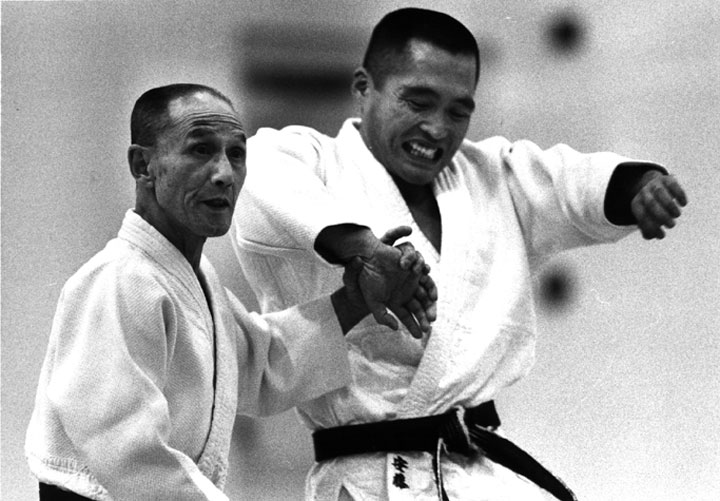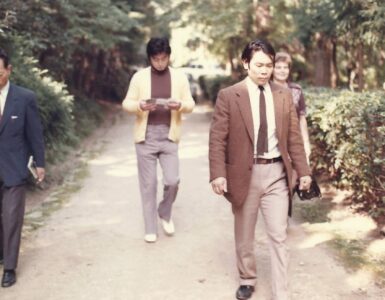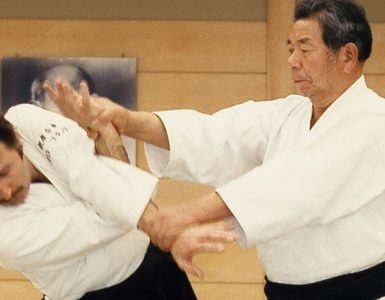The following translation from the Japanese-language autobiography entitled Aikido Jinsei (An Aikido Life) by Gozo Shioda Sensei of Yoshinkan Aikido is published with the kind permission of the author and the publisher, Takeuchi Shoten Shinsha. This series of installments began with AIKI NEWS no. 72. Read part six here.
Dream Of Starting A New Life In Manchuria And Mongolia
My father always told me that I should work in Manchuria and Mongolia in the future and suggested that it would be better for me to enter the Agriculture Department of Hokkaido Imperial University. However, although the department offered a course in agriculture, the institution was a government university and thus much more study than average was required. I was the type who did not like studying very much but I began reluctantly to apply myself little by little.
However, Headmaster Abe visited us around the month of April when I was in my fifth year of middle school. He told my father that Takushoku University was the most appropriate school for those wishing to start a new life in Manchuria and Mongolia. Therefore, my father told me to enter Takushoku University. The entrance rate of Takushoku University was low in those days and I had the necessary qualifications to enter this university without studying for the examination. Thus, I stopped studying altogether and devoted myself exclusively to the development of physical strength.
My father said to me: “In order to live in Mongolia you need to be prepared. You should study cooking and, of course, martial arts, horseback riding, and learn how to drive a car.”
The purpose of studying cooking was to enable me to cook and eat anywhere. I needed to train my mind and physical strength through the martial arts so that I would be able to manage a horse on the great plains of Mongolia. I also needed to obtain a driver’s licence so that I would be able to go anywhere. All of these things were indispensable for life in Manchuria and Mongolia.
Introduction To Aiki Jutsu
About that time Mr. Abe, the headmaster of the Sixth Junior High School, told the following story to my father:
“There is an extraordinarily interesting martial art called Aiki Jutsu. I learned about it from a lady that I met at Shoin Yoshida Sensei’s shrine. I admire him and worship at the Shoin shrine each morning. There is a lady who cleans the shrine every morning at the same time. Her mental attitude is outstanding and so I asked her name. She answered, ‘My name is Takako Kunigoshi.’ When I asked her what she did, she answered, ‘I practice Aiki Jutsu with Ueshiba Sensei.’ Then I asked, ‘What is Aiki Jutsu?’ and she said, ‘There is a saying: seeing is believing. How would you like to come with me to the dojo to see for yourself.’ So I made an appointment to visit the Ueshiba Dojo in Ushigome. I met Ueshiba Sensei and talked with him about various things; I saw his demonstration and was impressed by his wonderful technique. I have come here straight from the dojo with that experience still fresh in my mind. You should have your second son Takeshi (now Gozo) train in Aiki Jutsu.”
So I promised to go to the Ueshiba Dojo with Mr. Abe at five o’clock on the morning of May 23, 1932. Here let me regress a bit before describing that event. One day a high-ranking teacher of Shibukawa-ryu came to demonstrate at the Yoshinkan, my father’s dojo. After the demonstration, the instructor asked, “Would anyone like to try the technique?” Mr. Itsuki Hirura, who was an ex-sumo wrestler and an assistant instructor of judo at the Yotsuya Police Department, came forward. Before he could say, “I will …” he was already in front of the instructor. He tried his favorite technique of “uchimata”—throwing the opponent down by putting one’s leg between his legs. In an instant the instructor was thrown and flew high in the air. Having seen such demonstrations before, I believed that judo was the greatest martial art. Thus I personally did not think much of Aiki Jutsu.
Entering The Ueshiba Dojo
The day appointed for going to the Ueshiba Dojo finally arrived. At five o’clock in the morning, after we exchanged formal greetings, Ueshiba Sensei started his demonstration. I could have understood then what he was doing if I knew what I do now. However, in Aiki Jutsu, which I had never seen before, the throws were so controlled and so clean that it looked pretty unbelievable to me. When the ordinary demonstration ended, Ueshiba Sensei speaking in a Kansai accent said, “Mr. Shioda, would you like to try?” I rose deliberately on my feet and asked, “What am I supposed to do?” He answered, “Anything you want.” I think I was a little conceited then. I kicked out at him abruptly thinking, “What an impudent old man!” Before I noticed that Sensei’s hand touched my thigh, I was flung away. I got a nasty bang on the back of my head; I felt dizzy and could not stand up for a while. I thought I should reflect on my conduct, and immediately decided to train in Aiki Jutsu.
The purpose of studying cooking was to enable me to cook and eat anywhere. I needed to train my mind and physical strength through the martial arts so that I would be able to manage a horse on the great plains of Mongolia. I also needed to obtain a driver’s licence so that I would be able to go anywhere. All of these things were indispensable for life in Manchuria and Mongolia.
On May 23, 1932, I joined the Ueshiba Dojo, where there were about twenty live-in students. They practiced everyday from five in the morning until nine at night. However, the admission regulations were strict and two guarantors were required to join. In my case, the first guarantor was my father and the second was Mr. Abe, the headmaster of the Sixth Junior High School.
Training sessions outside the dojo were held mainly at the Army and Navy academies. The president of the naval academy was Admiral Sankichi Takahashi. Takamatsu-no-miya—younger brother of the emperor—was attending the school then. Other training places included the Nakano School, the Military Police School, the Army Toyama School, and a research institute affiliated with the East Asian Economic Research Bureau. Therefore, it was not necessary to accept new students in the Kobukan Dojo. There, emphasis was placed on the training of the “uchideshi” or live-in students. Since general members of the dojo did not come very regularly, it did not really make any difference if one person came or ten people came. We had to train with them every time. When I joined, I was a middle school student. I went to the dojo from my house in Yotsuya, either in the morning or in the evening. Since I could not skip school, I had to leave home at four o’clock in the morning. I ran from Yotsuya to the Ueshiba Dojo at Nuke-benten-mae in Ushigome Wakamatsu-cho and arrived at the dojo at about 4:40. I practiced from five to six o’clock and then went back home. After breakfast I finally set out for school.
Entrance Into Takushoku University
I decided I would devote myself to serious training after I entered the university. I was very proud that I had passed the entrance examination to Takushoku University with excellent scores. There was a two-year preparatory course and a three-year regular course. After entering the university, I was determined to master the Chinese language so I made it a rule to attend all the Chinese language lectures.
There I started tackling the actual training for the four necessities of the life in Manchuria and Mongolia. As I have already mentioned, they were: the martial arts, cooking, horsemanship, and driving a car. First, I went to the Ueshiba Dojo in the morning as usual, and then to the university. In the afternoon I took lessons in horsemanship for about two hours at Tokyo Horsemanship Research Institute in Meguro. Major Sueo Kiyoura, a son of Count Keigo Kiyoura, introduced me to the head of the institute, Mr. Shiro Kyuriki. Mr. Kyuriki, a master of horsemanship, was as good as Colonel Yusa. He served as a captain in the Army and worked as chief of the imperial horse ranch of the Imperial Household Agency. Mr. Kyuriki called himself a descendant of Jirocho or Shimizu and used to say boastfully that two or three hundred of his followers would come to him in no time if he went to Shimizu. For that reason, he was so pugnacious that he would try to pick a quarrel with anybody. Because of that bad habit, he disagreed with his boss and was fired. On the other hand, Mr. Kyuriki was a simple and pure-hearted man. He was very articulate and had a strong sense of justice. The chairman of the institute was Higashikuni-no-miya, a member of the Imperial family. There were also many renowned people in the institute, including Duke Ichijo and Mr. Taketora Ogata. Mr. Kyuriki’s method of teaching horsemanship was refined, and he was very strict with me. When I finished the riding lesson, it was about five o’clock in the afternoon. Then I went to the Imperial Hotel to work as a cook and also to study cooking. The manager of the hotel, Mr. Tetsuzo Inumaru, was a friend of my father. I learned mainly how to cook poultry, beef, pork, mutton, lamb, and so forth.
One day a high-ranking teacher of Shibukawa-ryu came to demonstrate at the Yoshinkan, my father’s dojo. After the demonstration, the instructor asked, “Would anyone like to try the technique?” Mr. Itsuki Hirura, who was an ex-sumo wrestler and an assistant instructor of judo at the Yotsuya Police Department, came forward. Before he could say, “I will …” he was already in front of the instructor. He tried his favorite technique of “uchimata”—throwing the opponent down by putting one’s leg between his legs. In an instant the instructor was thrown and flew high in the air. Having seen such demonstrations before, I believed that judo was the greatest martial art. Thus I personally did not think much of Aiki Jutsu.
By the time I came home it was about nine o’clock at night. I went straight to bed and that was the end of the day’s schedule. The next day I repeated the same routine. I took cooking and driving lessons every other day, and aikido and horseback riding classes every day. At night I was so exhausted that I slept deeply. Since I was still only nineteen years old at that time, I did not suffer from the strenuous schedule at all. I continued to follow that kind of life for about one year.
My Father’s Sudden Death
I entered the preparatory course of Takushoku University in 1933 and started the strenuous life which I have just described. One day, my father called me to tell me the following: “You should become the King of Mongolia. In order to do that, marry Doruhichichiku in the future (Japanese name Akiko Tanaka), the daughter of General Papuchappu, who is staying with us now. By doing that you will help reconstruct Mongolia. For that reason also, train even harder in aikido.”
I was determined. I told myself, “All right. I will train even harder. I will practice twice as much as other people to accumulate training experience. I will withdraw from school for two years to devote myself to training in aikido.” I started going to the Ueshiba Dojo before five o’clock every morning and trained until nine at night.
When I was a junior in the regular course at the university, my father suddenly passed away at the age of 53 as a result of a cerebral hemorrhage. It was about seven o’clock in the evening of April 9, 1938. All of my family, including myself, felt as though we had been thrown into an abyss and were overcome with great grief. We asked two people to administrate and handle the family’s assets. One was Mr. Tokuo Watanabe, one of our distant relatives, the head clerk of the Shibusawa family, and a managing director of Dai Nippon Beer Company. The other was Mr. Takezo Yamamoto, one of our relatives and the head of the Department of Technology of Tokyo Imperial University. My older brother was still a sophomore in the Medical Department of the Hokkaido Imperial University. Many of our servants had to leave, and we sold our house in Yot-suya, which was on an estate of 1,200 tsubo (1 tsubo = 3,954 square yards), along with some paintings, calligraphic works, and antiques. My brother and I made pledges to each other: “You my brother should become the best doctor in Japan. I will be embarking on great adventures in Manchuria. Let’s carry out our father’s intention together.” Our family moved into a rented house in Shinmachi in Sendagaya which had five rooms, and we kept one maid. My brother went back to school in Hokkaido.
The funds from selling our assets were kept in the Mitsubishi Trust Bank, and we lived off the interest. Without my father’s guidance and advice I was in a position to make my own decisions about how to live my life. I thought hard about what I should do in the future.
Founding A Private School With Comrades
There were four of us from the Takushoku University period that remained sworn friends: myself, Shiro Ogawa whose father was the head of the Red Cross Hospital in Ise City, Mie Prefecture, Motoyuki Kataoka, and a Mr. Yoshinaga. They always visited my house in Sendagaya and practically lived with us. Being carried away by youthful ardor, we talked about building a private school to gather together comrades with the same desire to venture abroad. We agreed that we should become leaders in Asia. However, in order to prepare for that, we would need a lot of money and would have to find a patron who would understand our intentions and sympathize with us. The person who immediately crossed my mind was Mr. Kyohei Matsuda, who was training at the Ueshiba Dojo at that time. I had talked with him in the dojo and knew that he was a man of high caliber. One day I met Mr. Matsuda at the dojo and asked him to listen to our story. He willingly consented to my request, and we went to a nearby tavern to talk. Mr. Matsuda listened to my story and quickly supported our idea of starting a private school. He was an extreme nationalist and acquainted with young military officers, including Mr. Chikara Nishida who was involved in the Incident of February 26 [7]. He also seemed to have some behind-the-scenes power in the political world. He was an adviser to Sumitomo Tsushin Company, the forerunner of the Nihon Electronic Company (NEC). His older brother, Mr. Matsuda, was considered to be a confidant of Mr. Fumimaro Konoe, a former prime minister. It is said that he wrote many of the prime minister’s speeches and was well-versed in the Chinese classics. Mr. Kyohei Matsuda was an equally learned man. I reported to my friends that Mr. Matsuda had agreed to support us. They danced for joy and we drank heavily and talked all night.
When I was a junior in the regular course at the university, my father suddenly passed away at the age of 53 as a result of a cerebral hemorrhage. It was about seven o’clock in the evening of April 9, 1938. All of my family, including myself, felt as though we had been thrown into an abyss and were overcome with great grief.
The four of us started action immediately. We rented a house with seven rooms in Kamiigusa, Suginami Ward, to make it into a private school. Mr. Kyohei Matsuda named it the Shido Juku. I asked General Shunroku Hata to write the name on a board to put up at the entrance. However, there were only four students in our school. At that time there were also various private schools including the Toa Juku in Takushoku University.
In the meantime, I continued to go to the Ueshiba Dojo as usual. However, it seemed to me that live-in students got stronger faster. I thought that I should live close to Ueshiba Sensei to absorb everything I could from him. I asked Sensei, and he readily agreed. In this way I was able to become a live-in student. I lived with Sensei, doing everyday work such as morning cleanup and washing Sensei’s back when he took a bath. Ueshiba Sensei came to regard me with special affection. Two years after I joined, I was able to accompany him to training sessions outside the dojo. During that period, several live-in students who were senior to me left. Before I knew it, I became one of the seniors of the group.













Add comment